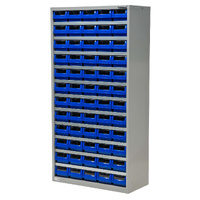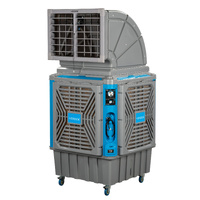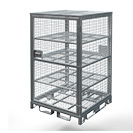The Future of Smart Handling Equipment in the Workplace
Date Posted:18 November 2024
By enhancing efficiency, improving safety, and providing valuable data insights, these advanced systems can drive significant benefits for businesses.
As technology continues to advance at a rapid pace, the workplace is undergoing a significant transformation. Smart handling equipment, characterised by its integration of artificial intelligence (AI), the Internet of Things (IoT), and automation, is becoming increasingly prevalent. This evolution is not only changing the way businesses operate but also enhancing safety, efficiency, and productivity. In this blog, we will explore the future of smart handling equipment in the workplace, examining its benefits, challenges, and potential developments.
Understanding Smart Handling Equipment
Smart handling equipment refers to tools and machinery that are equipped with advanced technology to monitor, control, and optimise their operations. Examples include smart forklifts, automated guided vehicles (AGVs), and intelligent trolleys. These devices are designed to communicate with other equipment and systems, allowing for real-time data collection and analysis.
The Benefits of Smart Handling Equipment
1. Enhanced Efficiency and Productivity
Smart handling equipment can significantly improve efficiency and productivity in the workplace. For instance, automated forklifts can operate continuously without breaks, leading to faster material handling and reduced downtime. Additionally, the integration of AI enables these machines to learn from their environment, making adjustments to optimise performance over time. This adaptability leads to smoother operations and better resource allocation.
2. Improved Safety
Safety is a top priority in any workplace, and smart handling equipment is designed with this in mind. Advanced sensors and cameras allow machines to detect obstacles and navigate their surroundings autonomously. This capability minimises the risk of accidents and injuries caused by human error. Moreover, predictive analytics can be used to identify potential hazards before they become serious issues, allowing for proactive measures to be taken.
3. Real-Time Data Insights
One of the most significant advantages of smart handling equipment is its ability to collect and analyse data in real time. This data can provide valuable insights into operational efficiency, equipment performance, and inventory management. Businesses can leverage this information to make informed decisions, streamline processes, and identify areas for improvement. For instance, data analytics can reveal patterns in material handling that lead to more effective workflow designs.
4. Cost Savings
While the initial investment in smart handling equipment may be substantial, the long-term cost savings can be significant. By reducing manual labour requirements and improving efficiency, businesses can lower their operational costs. Additionally, predictive maintenance powered by data analytics can minimise equipment downtime and repair costs, further enhancing financial savings.
5. Sustainability
Smart handling equipment can also contribute to a more sustainable workplace. Many of these devices are designed to be energy-efficient, using advanced technologies to reduce power consumption. Furthermore, optimised logistics and inventory management can lead to less waste, reduced carbon footprints, and more responsible resource utilisation.
Challenges to Adoption
Despite the numerous benefits, the adoption of smart handling equipment does come with challenges:
1. High Initial Investment
The cost of acquiring and implementing smart handling equipment can be prohibitive for some businesses, particularly small to medium enterprises (SMEs). While the long-term savings are evident, the upfront costs can deter companies from making the transition.
2. Skill Gap
The integration of smart technology requires a workforce that is knowledgeable and skilled in operating these advanced systems. Many employees may require additional training to adapt to the new technology, which can be time-consuming and costly.
3. Cybersecurity Risks
As handling equipment becomes increasingly connected to the internet, the risk of cyberattacks grows. Businesses must implement robust cybersecurity measures to protect their systems and data from potential breaches.
4. Resistance to Change
Employees may resist the adoption of new technologies due to fears of job displacement or discomfort with unfamiliar systems. Addressing these concerns through communication, training, and support is essential for a smooth transition.
Future Developments in Smart Handling Equipment
The future of smart handling equipment is promising, with several key developments on the horizon:
1. Increased Automation
As technology continues to evolve, we can expect to see a greater level of automation in handling equipment. This may include fully autonomous warehouses where robots and smart devices manage the entire material handling process, from receiving shipments to inventory management and order fulfilment.
2. Advanced AI and Machine Learning
The integration of advanced AI and machine learning algorithms will enhance the decision-making capabilities of smart handling equipment. These systems will be able to predict demand fluctuations, optimise routing, and improve supply chain efficiency based on historical data and real-time analytics.
3. Greater Interconnectivity
As IoT technology advances, smart handling equipment will become more interconnected, allowing for seamless communication between devices. This interconnectedness will enable real-time coordination of tasks and resources, leading to improved efficiency and reduced delays.
4. Enhanced User Interfaces
Future smart handling equipment will feature more intuitive user interfaces, making it easier for employees to operate and interact with machines. Augmented reality (AR) and virtual reality (VR) technologies may be integrated to provide immersive training experiences and real-time guidance for operators.
5. Focus on Sustainability
The future of smart handling equipment will likely place an increased emphasis on sustainability. As businesses strive to reduce their environmental impact, innovations in eco-friendly materials and energy-efficient designs will play a crucial role in the development of new equipment.
The future of smart handling equipment in the workplace is bright, with the potential to transform operations across industries. By enhancing efficiency, improving safety, and providing valuable data insights, these advanced systems can drive significant benefits for businesses. While challenges to adoption remain, the long-term advantages make a compelling case for investing in smart handling equipment.
As we look ahead, businesses must embrace the opportunities presented by these innovations, focusing on training their workforce, addressing cybersecurity concerns, and fostering a culture of adaptability. By doing so, organisations can position themselves at the forefront of the smart handling revolution, reaping the rewards of a more efficient, safer, and sustainable workplace. In an ever-evolving landscape, staying ahead of the curve is essential for success, and smart handling equipment will undoubtedly play a pivotal role in shaping the future of work.
































































































































 Trolleys & Hand Trucks
Trolleys & Hand Trucks Cage Trolleys
Cage Trolleys Cleaning Carts & Trolleys
Cleaning Carts & Trolleys Construction Trolleys
Construction Trolleys Custom Trolleys
Custom Trolleys Hand Trucks & Dollies
Hand Trucks & Dollies Laundry/Linen Trolleys
Laundry/Linen Trolleys Lifting Trolleys
Lifting Trolleys Order Picking Trolleys
Order Picking Trolleys Panel Cart Trolleys
Panel Cart Trolleys Platform Trolleys
Platform Trolleys Powered Trolleys
Powered Trolleys Shelf & Tiered Trolleys
Shelf & Tiered Trolleys Shopping Trolleys
Shopping Trolleys Stainless Steel Trolleys
Stainless Steel Trolleys Tool Trolleys
Tool Trolleys Utility & Service Carts
Utility & Service Carts Lifting & Handling Equipment
Lifting & Handling Equipment Forklift Attachments
Forklift Attachments Jib Attachments
Jib Attachments Lifting Hoists & Pallet Hooks
Lifting Hoists & Pallet Hooks Load Skates & Tow Tugs
Load Skates & Tow Tugs Manual Stackers & Lifters
Manual Stackers & Lifters Pallet Jacks
Pallet Jacks Pallet Lifters
Pallet Lifters Pallet Rotators & Dispenser
Pallet Rotators & Dispenser Powered Pallet Trucks & Electric Lifters
Powered Pallet Trucks & Electric Lifters Scissor Lift Trolleys and Tables
Scissor Lift Trolleys and Tables Conveyor Equipment
Conveyor Equipment Conveyor Frames & Stands
Conveyor Frames & Stands Roller & Skate Conveyors
Roller & Skate Conveyors Ladders & Access Equipment
Ladders & Access Equipment Container & Yard Ramps
Container & Yard Ramps Ladders & Step Stools
Ladders & Step Stools Work Platforms & Crane Cages
Work Platforms & Crane Cages Drum Handling Equipment
Drum Handling Equipment Drum Storage & Bunding
Drum Storage & Bunding Drum Trolleys & Lifters
Drum Trolleys & Lifters Forklift Drum Handling
Forklift Drum Handling Waste Handling & Bins
Waste Handling & Bins Bin Lifters & Tippers
Bin Lifters & Tippers Plastic Waste & Wheelie Bins
Plastic Waste & Wheelie Bins Steel Waste & Tipping Bins
Steel Waste & Tipping Bins Waste Carts
Waste Carts Dangerous Goods Storage & Spillage
Dangerous Goods Storage & Spillage Aerosol Cans Storage Cages
Aerosol Cans Storage Cages Bunded Pallets & Storage
Bunded Pallets & Storage Corrosive Goods Storage Cabinets
Corrosive Goods Storage Cabinets DG Storage & Trolleys
DG Storage & Trolleys Flammable Liquid Cabinets
Flammable Liquid Cabinets Forklift Gas Storage Cages
Forklift Gas Storage Cages Site Storage
Site Storage Spill Kits
Spill Kits Shelving & Storage Equipment
Shelving & Storage Equipment Stillage & Transport Cages
Stillage & Transport Cages 750 Series Cage Configurations
750 Series Cage Configurations Heavy Duty Cabinets
Heavy Duty Cabinets Heavy Duty Shelving
Heavy Duty Shelving Mega Bins & Pallets
Mega Bins & Pallets Packing & Workbenches
Packing & Workbenches Parts Trays & Stor-Pak Bins
Parts Trays & Stor-Pak Bins Pegboard & Louvre Panels
Pegboard & Louvre Panels Plastic Bins & Crates
Plastic Bins & Crates Plastic Handling Solutions Bins
Plastic Handling Solutions Bins Plastic Pallets
Plastic Pallets Stack & Nest Bins
Stack & Nest Bins Pallet Racking Accessories
Pallet Racking Accessories Workplace Equipment
Workplace Equipment Modular Workbenches
Modular Workbenches Electric Height-Adjustable Workbenches
Electric Height-Adjustable Workbenches Floor Matting
Floor Matting General Workplace Equipment
General Workplace Equipment Industrial Weighing Scales
Industrial Weighing Scales Packaging Machinery
Packaging Machinery Stationery Cupboards
Stationery Cupboards Storage and Stillage Cages
Storage and Stillage Cages Tool Trolleys
Tool Trolleys Tooling Cabinets
Tooling Cabinets Workshop Fans and Coolers
Workshop Fans and Coolers Safety Barriers, PPE & Signage
Safety Barriers, PPE & Signage Barriers & Bollards
Barriers & Bollards First Aid Equipment
First Aid Equipment Gloves, Knives and PPE
Gloves, Knives and PPE Signage
Signage Cleaning & Site Supplies
Cleaning & Site Supplies Cleaning Equipment
Cleaning Equipment Cleaning Trolleys
Cleaning Trolleys Rubbish Bins
Rubbish Bins Signs & Traffic Supplies
Signs & Traffic Supplies Construction Equipment
Construction Equipment Construction Trolleys
Construction Trolleys Waste Handling
Waste Handling General Site Equipment
General Site Equipment Concrete Equipment
Concrete Equipment Site Storage
Site Storage Lifting Equipment
Lifting Equipment Verdex Specials
Verdex Specials









